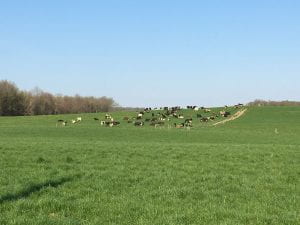by Nancy Glazier
 Rotational grazing is the optimum way to utilize pastures. Shorter rotations are more efficient; dairy cows are generally moved to fresh paddocks twice a day while other livestock once a day to once a week. After 3 days on the same paddock, livestock will graze the regrowth and will delay further growth. I do not recommend continuous grazing unless there is much more pasture than the livestock can utilize. This method of grazing leads to poor quality pastures.
Rotational grazing is the optimum way to utilize pastures. Shorter rotations are more efficient; dairy cows are generally moved to fresh paddocks twice a day while other livestock once a day to once a week. After 3 days on the same paddock, livestock will graze the regrowth and will delay further growth. I do not recommend continuous grazing unless there is much more pasture than the livestock can utilize. This method of grazing leads to poor quality pastures.
Ideal grazing height is 8-10″. Can you wait that long to start grazing? No. Wait for the grass to get some growth and look at the number of leaves on the grass plants, more than 3 leaves. Some research indicates to count leaves not inches. Grazing when the grass is too small will remove the growing point which will slow regrowth. Flash graze if necessary; move the animals through quickly to prevent damage to growing points. If the soil is wet start grazing when there is a quantity of pasture that will help protect the soil from hoof action.
Where to start? This may depend on what ground is dryer or what grasses have more growth. Some pastures may be better suited for mechanical harvest so keep that in mind when beginning the grazing season. A rule of thumb to start the season is you will need to harvest half since the livestock cannot keep up. If too much pasture gets ahead of you harvest excess as hay, clip the paddocks closely, or bring in another group of animals. This will encourage tillering of the grass plants. Last season’s residue helps to protect the soil, too.
Watch out for grass tetany early in the season! This is caused by a nutritional or metabolic disorder from a deficiency of blood magnesium. There may be several processes involved that lead to the deficiency. Early lactation and older cows are more susceptible due to mobilizing magnesium more readily. Signs begin with nervousness and staggering. By the time you see this, it may be too late. Make sure you have a high magnesium supplement available on pasture, feed some legume hay, and wait until there is sufficient growth.
Keeping residual (what is left after grazing) height taller encourages regrowth of the taller plants. Native species such as Kentucky bluegrass, annual bluegrass, less-productive clovers (Dutch white clover in your lawn), along with weeds do well under short conditions. Leaving the residual taller will encourage the more productive, taller plants to flourish and stay productive. Take half, leave half is a good rule of thumb, which equates to roughly 4”. If the residual is coarse, it may need to be clipped back. This is a balancing act between regrowth and risking eye irritations which may lead to pinkeye.
Rest period is just as important as residency period. Pastures need adequate time for regrowth to remain productive. Spring conditions that are cool and moist encourage fast regrowth, 10-14 days, hot and dry conditions may warrant 30-40 days.
A big problem is leaving grazing animals out too late in the fall. I have been told by a seasoned grazier that one day more in the fall will be three days less grazing in the spring. Grass plants need root and rhizome reserves (stored energy) to begin spring growth. There will be little leaf material to capture sunlight for photosynthesis so energy to begin growth is supplied by the stored carbohydrates. This can’t be helped now but keep this in mind in the fall.
A great way to learn about grazing is to attend a pasture walk. Those that host one learn more than those that attend, so I have been told! If you would like to host, just drop me an email or give me a call!

